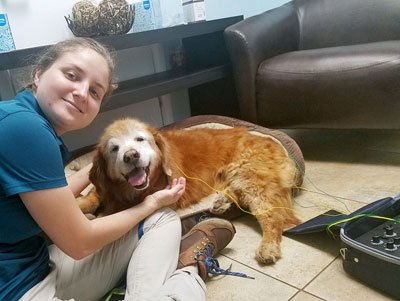What You Can Do To Help Manage Your Pet’s Pain: A Multimodal Approach To Osteoarthritis

Our pets are very stoic when it comes to showing pain and often times it can be easily over looked. As guardians to our furry friends, we want to make every attempt to be sure they are as comfortable as possible, especially as they age. One of the most common reasons for pain and decreased mobility in the older dog is osteoarthritis (OA). Osteoarthritis is the gradual wearing down of the protective surfaces between bones which make up the joint. It can lead to thickening of the joint capsule which decreases range of motion at the joint resulting in abnormal postures, compensation, and increased stress placed on the joint capsule. This leads to pain during movement which results in decreased use of the limb and muscle loss which further contributes to pain during movement. You may notice your dog not wanting to move as much as he had when he was younger, stiffness when he gets up from lying down, difficulty or slow to get up/down, soreness after increased activity, or seeking warm places/comfortable bedding.
There are many things that you can do to make your pet more comfortable. The first step is visiting your veterinarian to establish an appropriate diagnosis of the problem and prescription of medication, if necessary. Many people dislike the idea of using medication to control pain for their pets, however when appropriate, it is necessary to ensure the pet’s comfort and continued mobility and quality of life. You, your vet, and your pet will work closely to determine a medication regimen that helps to control pain and limit side effects. Your vet may also make suggestions for weight management. Studies suggest that dogs with hind leg lameness due to OA will respond positively to weight reduction and can even display observable improvements in hind limb use!
Physical rehabilitation is another way to decrease your pet’s pain and improve the pet’s mobility and overall quality of life. A qualified rehabilitation professional can evaluate your pet’s muscle flexibility, joint range of motion, and muscle strength in order to provide an exercise and treatment program. You will be instructed in a home exercise program to perform with your pet. By improving flexibility, muscles can move through their full range of motion which decreases chance for compensation. It is necessary to improve joint range of motion so that certain parts of the joint capsule do not endure excessive stress. Furthermore, strengthening of the muscles around a joint will help to decrease the load placed on the joint by acting as shock absorption and assist with decreasing pain. Rehabilitation can also consist of tools and techniques to decrease pain such as cold therapy to decrease discomfort and inflammation from an acute flare up; heat therapy to improve muscle flexibility and joint comfort; laser therapy to decrease pain and improve blood flow to tissues; and TENS (electrical stimulation therapy) to decrease pain or to improve muscle strength. Body work including massage and joint mobilizations are also excellent techniques to decrease pain and improve the way your pet moves. Your rehab therapist can also instruct you how to safely massage and stretch your dog.
It is important to consider the home environment when managing your pet’s pain. By placing area rugs or carpet runners, pets will have improved traction and decreased chance of slipping. Depending on your pet’s current level of mobility, it may be best to contain the pet to the ground level of your home so that they do no have to go up/down stairs. If your pet must go up/down steps to go outside, it is best to have a ramp with a non-skid surface to improve ease of access. Does your dog love car rides but has difficulty getting in/out of the car? You can make or purchase a ramp so that your pet can get into and out of the car easier. Another tip is to elevate your pet’s food and water dishes so that the dish is about elbow height so that he does not have to bend down to the floor. Also, ensure that your pet has comfortable bedding that is away from areas that have temperature and humidity fluctuations. Many pets find it most comfortable if the bed is slightly elevated off of the floor. One of the most important things that you can do for your pet is to exercise them regularly by taking them for short but frequent daily walks on soft surfaces like grass. Dogs with OA tend to flare up and become more painful if they are taken for long walks on the weekends.
As you can see, there are many things that you can do to help your furry family member enjoy his “golden years.” By maintaining regular vet check ups and making the home environment modifications as stated, you can help to ensure your pet’s comfort.
If you feel your pet can benefit from rehabilitation, please contact your veterinarian for a referral.
Download PDF handout:
What You Can Do To Help Manage Your Pet’s Pain: A Multimodal Approach to Osteoarthritis
- Behavior (11)
- Caring for your pet (261)
- cat (4)
- Community Events (19)
- dog (6)
- From Our Clients (15)
- Happy Tails (8)
- News (416)
- Press (53)
- Products (2)
- Questions (4)
- Recalls (1)
- Special Offers (5)
- Tips & Advice (231)
- Uncategorized (19)
- Veterinary Services (48)
